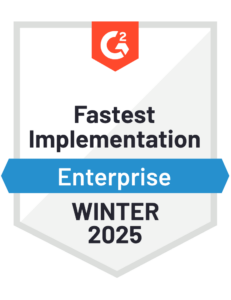Automation: One of the CFO’s Top Priorities In 2025
Blog post
Share
This blog was written by Trintech CFO Omar Choucair and originally appeared on Forbes.com. It is republished with permission.
This year is set to be a pivotal one for businesses navigating growth. Chief financial officers (CFOs) will face the dual challenge of driving expansion while ensuring operations remain efficient, resilient and sustainable. As the pace of business accelerates, expectations for faster reporting, reliable forecasting and strategic decision-making have never been higher.
Making sense of data will be critical, with 72% of CFOs identifying metrics, analytics and reporting as their top priorities for 2025. Meeting these priorities will require a shift away from traditional finance functions toward models that leverage automation and innovation. The road to smart, sustainable growth lies in optimization, not just expansion.
The CFO as a Strategic Leader In AI Adoption
In the race to adopt artificial intelligence (AI), organizations can easily get caught up in the hype without a clear strategy. For CFOs, this presents both a challenge and an opportunity. As stewards of financial health and strategic growth, CFOs are taking the lead in critically evaluating AI initiatives across the entire organization. Rather than rushing into adoption, they need to collaborate with their teams to develop and validate robust use cases that clearly outline the potential benefits, costs, legal governance and return on investment (ROI) of AI applications.
From improving engagement and streamlining human resources (HR) processes to revolutionizing financial planning and analysis (FP&A) with predictive analytics, AI holds immense potential to transform key business functions. However, realizing this potential requires a deliberate, data-driven approach. CFOs should prioritize pilots and proofs of concept that align AI initiatives with the organization’s strategic objectives. By testing ROI and ensuring scalability, they can better avoid wasted investments and focus resources on AI solutions that truly add short-term and long-term value.
Automation: The Foundation Of Smarter Growth
As the qualified labor pool continues to shrink, it is becoming increasingly difficult to attract top talent for finance-related roles. Automation inside the office of the CFO has emerged as a key driver of smarter, more strategic growth. It can help free finance and accounting teams from manual, time-intensive tasks, allowing them to focus on higher-value activities like strategic planning and data analysis.
Far from being just a cost-cutting measure, automation acts as a growth enabler by providing CFOs with tools to scale operations without proportionally increasing overhead. It can strengthen organizational resilience, offering systems that can adapt to market fluctuations and demands. Predictive analytics powered by automation can equip CFOs to anticipate challenges and seize opportunities, making the organization nimbler in its response to change.l design and enabling foundations, the opportunity to achieve impressive results may be out of reach for many organizations. CFOs know this and are taking action.
Collaboration with the chief information officer (CIO), in particular, will be critical in evaluating which automation investments deliver the greatest value while ensuring that they are scalable, secure and aligned with broader business strategies. Without this critical CFO and CIO partnership, large and complicated automation projects risk becoming siloed, leading to inefficiencies, budget overruns or technology implementations that fail to meet business needs. By working together, the CFO and CIO can identify opportunities where automation can help streamline workflows, enhance decision-making and improve overall resilience.
Increasing Automation Benefits In The Finance Function
With automation, finance teams gain the capacity to pivot quickly to address emerging priorities. The advantages of automation extend across all facets of the finance function, transforming how CFOs operate and deliver value:
Enhanced Reporting And Accuracy: Automation better ensures data consistency and can minimize errors in financial reports, boosting credibility and decision-making.
Scalability: Automated systems can effortlessly handle increased transaction volumes, enabling seamless growth without additional strain on resources.
Real-Time Insights: CFOs gain access to up-to-the-minute data, empowering them to make informed decisions and stronger management discussion and analysis (MD&A) faster than ever before.
Cost Savings: Automation reduces reliance on manual processes, driving operational efficiency and allowing for better resource allocation.
Key Areas For Automation In 2025
To unlock its full potential, CFOs should prioritize automation in the following areas:
Financial Close Processes: Automating reconciliation and reporting can shorten close cycles, improve accuracy and enhance compliance.
Data Integration: Automation only works if the data that is being used is trustworthy. Clean and reliable data feeds across the technology stack, including enterprise resource planning (ERP), FP&A, financial close, HR and treasury systems.
Accounts Payable/Receivable: Automated payment workflows can help smooth cash flow, process faster and reduce operational bottlenecks.
Budgeting And Forecasting: Real-time, data-driven insights empower CFOs to craft precise and adaptable financial plans.
Compliance And Audit: Automation can simplify regulatory reporting and mitigate risks by checking adherence to compliance standards.
The CFO’s Road Map To Smart And Efficient Growth
As 2025 unfolds, CFOs must take decisive steps to ensure their organizations are prepared to capitalize on growth opportunities. Sustainable growth requires scalable, flexible systems, and automation can serve as the foundation of this transformation. Here’s how CFOs can drive smart growth:
Collaborating Across Leadership: Work closely with the C-suite to articulate the value of automation as a strategic investment, not just an operational upgrade.
Auditing Existing Processes: Conduct a thorough evaluation of current finance workflows to identify inefficiencies and opportunities for automation.
Partnering With Technology Providers: Choose solutions that are flexible, scalable and tailored to the organization’s unique needs.
Aligning Automation With Strategic Goals: Focus on automation initiatives that deliver both immediate efficiencies and long-term strategic value.
Automation not only supports growth but aligns with broader sustainability goals by minimizing resource consumption and environmental impact. Optimized processes free up resources for innovation and strategic initiatives, allowing CFOs to position finance as a revenue-driving function.
A Blueprint For Success In 2025
There are unprecedented opportunities in 2025 for organizations willing to embrace change and innovation. For CFOs, the path to success lies in automation investment into the finance function. This isn’t just about speeding up processes or cutting costs—it’s about unlocking smarter, faster and more sustainable ways to grow.
In an era where finance is increasingly viewed as a strategic driver of business success and CFOs are being asked to take on more nonfinancial roles than ever before, automation is no longer optional. It is the key to building a future-ready organization equipped to thrive.






